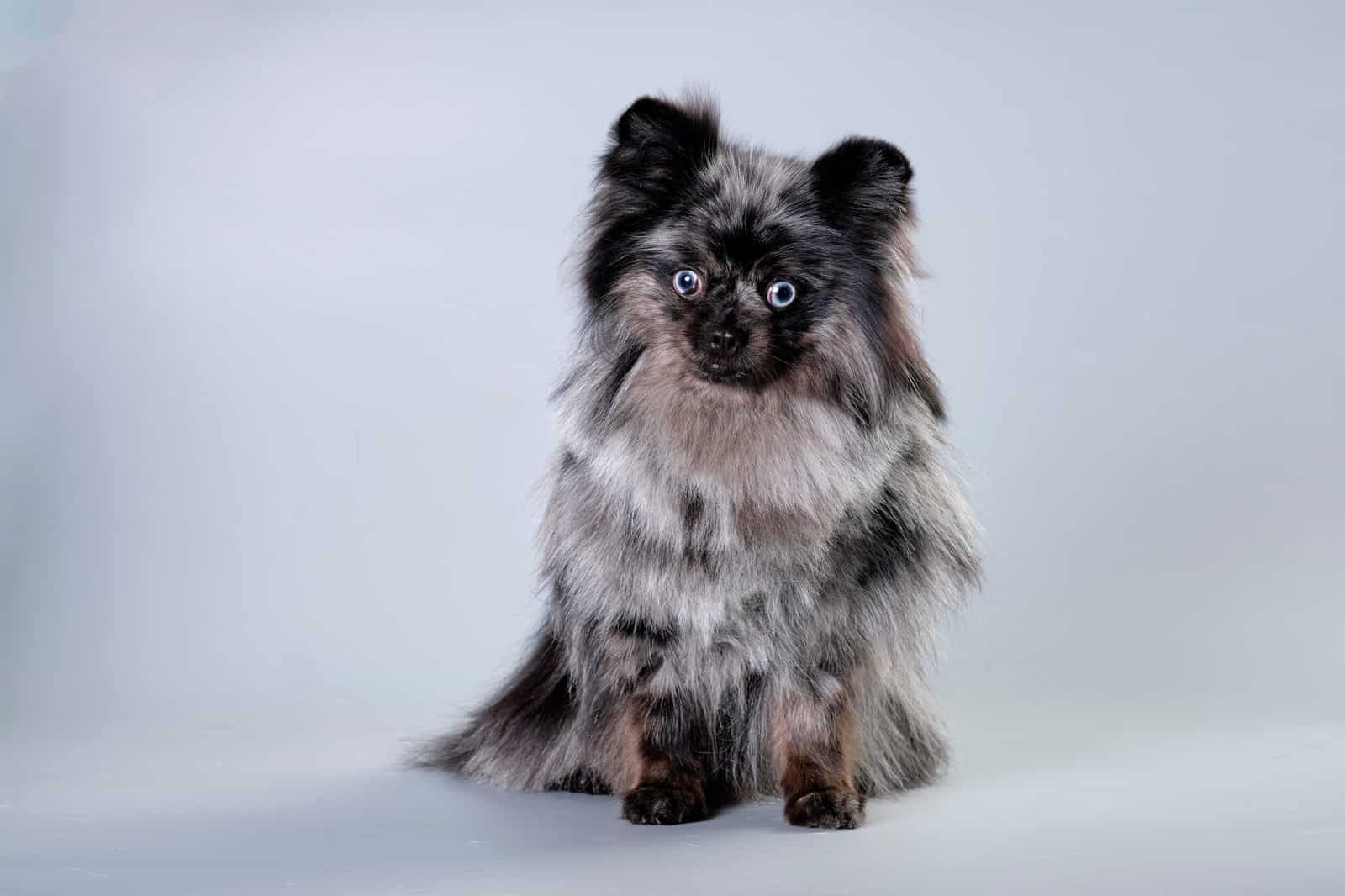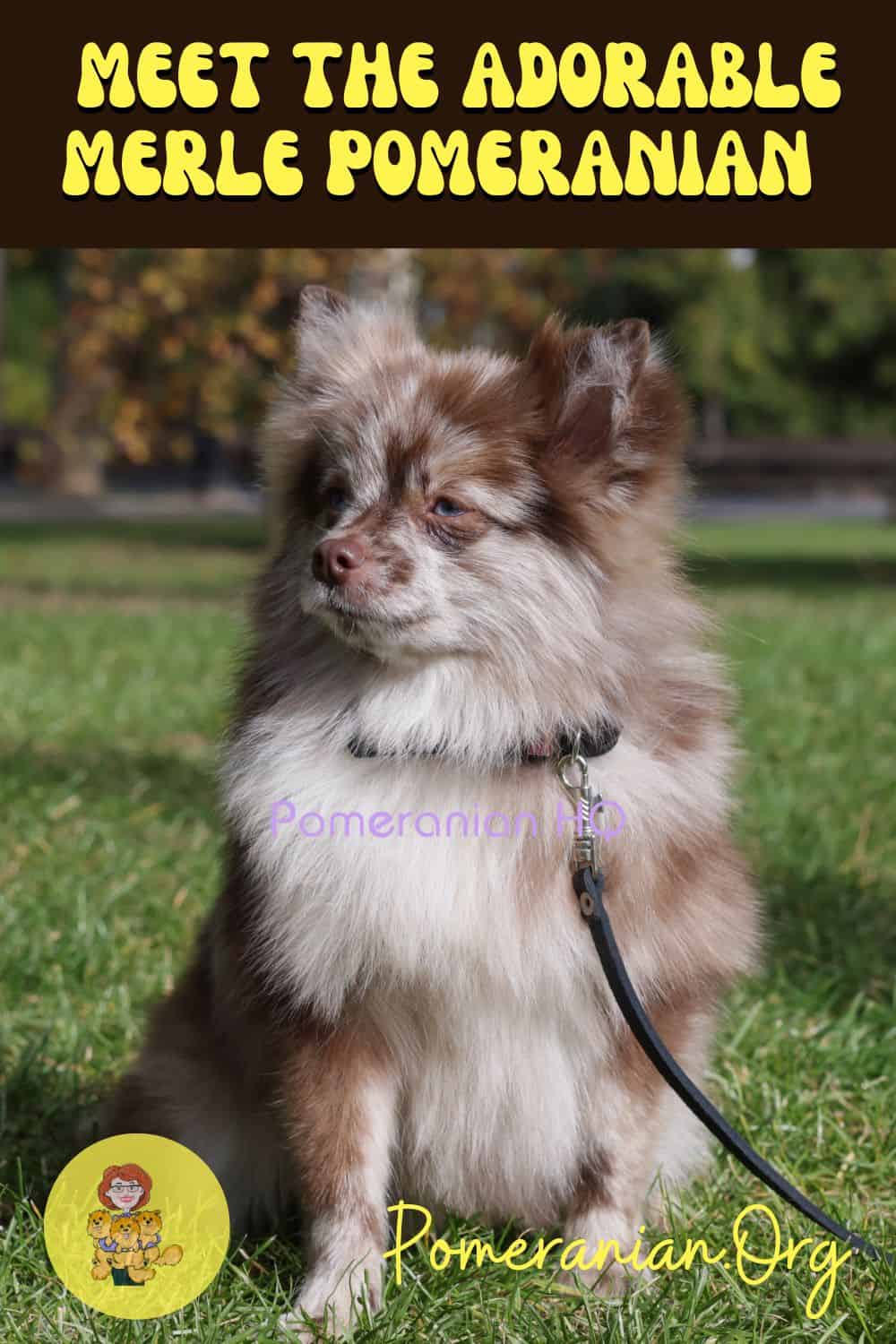Last Updated on March 20, 2024 by Denise Leo. Post first published on June 4, 2023.
Want to learn more about the colors and patterns of Merle Pomeranians? Discover how their mottled coat pattern is caused by the Merle gene and the various color possibilities here with Canine Pals! As a dog lover, I’ve always been fascinated by the different dog breeds, especially small dogs and their unique characteristics.
One breed that has caught my attention recently is the Merle Pomeranian. These adorable dogs are known for their distinct coloring, which sets them apart from other Pomeranians.
Merle Pomeranians have a mottled or speckled pattern on their coats, which can come in various colors, such as orange, red, brown, or black.
This coat color pattern is caused by the Merle gene, which modifies the color of the dog’s coat. However, it is essential to note that not all countries recognize Merle Pomeranians as an accepted color pattern, and breeding two Merle Pomeranians together can lead to health issues for the offspring.
Despite these concerns, Merle Pomeranians continues to be a popular dog breed among pet owners.
In this article, we’ll explore everything you need to know about Merle Pomeranians, from their history and origin to their temperament and care requirements. So, if you’re considering adding one of these adorable pups to your family, keep reading to learn more!

What is a Merle Pomeranian?
As a proud owner and breeder of show Pomeranians, I can tell you that these dogs are a unique and exciting addition to the Pomeranian breed. Merle is a coat color pattern that affects a Pomeranian’s coat, eyes, and nose, and it creates a mottled or speckled effect that is often described as “marbled” or “swirled.”
The Merle gene is known to be not naturally occurring in Pomeranians, and it is thought breeders may have introduced it from other breeds to produce Merle Pomeranians.
It’s important to note that breeding two Merle Pomeranians together can result in a double Merle, which can cause health issues such as blindness and deafness.
Therefore, responsible breeders will only breed a Merle parent with non-Merle Pomeranians. There are several types of Merle Pomeranian puppies, including blue merle Pomeranian, chocolate merle, orange merle, beaver merle, and many more.
Each type has its unique coloring and pattern. Blue merle Pomeranians, for example, have a grayish-blue base coat with black patches, while orange merle Pomeranians have a reddish-orange base coat with darker orange patches.
Merle Pomeranians can come in many colors and patterns, such as sables and brindles. Notably, not all Pomeranian breed standards recognize Merle Pomeranians as an accepted color pattern.
A Merle Pomeranian has a unique color pattern that affects the coat, eye color, and nose. Breeders must introduce the Merle gene from other breeds, and responsible breeding practices should be followed to avoid health issues. Merle Pomeranians come in various colors and patterns, including blue, orange, beaver, and chocolate.
The American Kennel Club Pomeranian Breed Standard lists blue eyes as a disqualification.
Disqualification – Eye(s) light blue, blue marbled, blue flecked.

Merle Pomeranian Coat Patterns
In this section, I discuss the various coat color patterns in a Merle Pomeranian.
Merle Pattern
The Merle pattern is the most well-known and popular coat pattern in Merle Pomeranians. This pattern is characterized by irregular blotches of color on a solid base color.
The Merle coat pattern can come in various colors, including red, black, blue, and cream. The Merle coat color pattern is caused by a dominant gene that affects how the coat coloring is expressed.
Parti Pattern
The Parti pattern is another typical coat pattern in Pomeranians. A white base coat color with patches of another color characterizes this pattern. Parti-patterned Pomeranians can come in various colors, including orange, brown, and black.
Parti-patterned Pomeranians can also have tan markings around their eyes, ears, chest, nose and paw pads. The parti male Pomeranians with tan markings are called tri-colored merle parti. Pomeranians may also have inherited the merle gene and have merl markings on their color patches.
Solid Base Color with White Markings
Some Merle Pomeranians have a solid base color with white markings, e.g., a white toe, white leg, and white blaze. This type of coat pattern is usually referred to as mismarked.
The white markings can appear on the chest, legs, and other body parts. Solid base color Pomeranians can come in various colors, including lavender, chocolate, and beaver.
Merle Pomeranians come in a variety of coat patterns that are truly unique and beautiful. Whether you prefer the Parti or solid merle color pattern, there is a Merle Pomeranian for everyone.
Just remember to be cautious when breeding Merle Pomeranians, as breeding two Merles together can result in health problems for the puppies.

Health Issues with Merle Pomeranians
As an experienced Pomeranian breeder of many decades, I am aware of the potential health issues that they may face. Some of the common health problems that Merle Pomeranians may experience:
Deafness and Blindness
Merle Pomeranians are prone to deafness and blindness, which the Merle gene can cause. The Merle gene can affect the development of the inner ear and the optic nerve, resulting in hearing and sight issues. It is essential to have your Merle Pomeranian’s hearing and sight checked regularly by a veterinarian to address any health issues promptly.
Microphthalmia
Microphthalmia is a condition where the eyes are abnormally small, which can result in vision problems. This condition is more common in Merle Pomeranians compared to other Pomeranians. Having your Merle Pomeranian’s eyes vet checked regularly is crucial to detect any issues early on.
Luxating Patella
A luxating patella is where the kneecap dislocates from its normal position, causing pain and discomfort. This condition is more common in smaller dog breeds, including Pomeranians. It is essential to keep your Merle Pomeranian at a healthy weight and to provide regular exercise to help prevent this condition.
Double-Merle Dogs
Double-merle dogs inherit two copies of the merle gene, one from each parent. Double-Merle dogs are at a higher risk of developing health issues, including deafness, blindness, and other eye abnormalities.
Merle Pomeranian breeders must avoid breeding two Merle Pomeranians together to prevent the risk of producing double-merle offspring.
As a responsible breeder or pet owner, it is vital to be aware of any potential health issues that Merle Pomeranians may face.
Regular veterinary check-ups, proper grooming, and a healthy diet and exercise routine can help prevent or manage these health issues.
History of Merle Pomeranians
I find it fascinating to learn about the history of different dog breeds; the Merle Pomeranian is no exception. Merle is not a naturally occurring pattern in the Pomeranian breed, so at some point, another breed was bred into the Pomeranian line to produce merle offspring.
The Merle Pomeranian is not recognized in most breed standards other than the American Kennel Club Pomeranian breed standard. Although it’s still being determined when exactly Merle Pomeranians started showing up, it has only been within the last few decades.
The earliest records of Pomeranians in history date back to the Pomerania region, an area in northeast Europe that today makes up parts of Poland and Germany. This is where the ancestors of the Pomeranian were bred from larger Arctic sled dogs.
Over time, the Pomeranian breed became popular with royalty, including Queen Victoria. She owned a particularly small Pomeranian, which helped decrease the breed’s size by half during her life alone.
The smaller variety of Pomeranian became universally popular, and many royal owners have made the breed famous. Back in the 17th century, the Pomeranian colors and patterns were minimal.
“mostly of a pale yellow or cream colour, and lightest in the lower parts; some are white, a few black, and others, but very rarely, spotted.”
William Taplin’s “The Sportsman’s Cabinet.”
The history of Pomeranians is a fascinating one that spans centuries and continents. From their origins in Pomerania to their popularity with royalty and their recognition by the American Kennel Club, Merle Pomeranians have a rich and storied history that is worth learning about.
Today, the Merle Pomeranian is recognized by the American Kennel Club and is a beloved companion dog for many families. With their unique coat pattern and charming personalities, it’s no wonder that Merle Pomeranians continue to capture the hearts of dog lovers worldwide.

Frequently Asked Questions
Are Blue Merle Pomeranians Hard to Find?
In my experience, a blue merle Pomeranian puppy can be harder to find than other merle colors, and this is because blue Merle is a less common color and requires specific breeding to achieve. However, with some patience and persistence, finding a blue Merle Pomeranian from a reputable breeder is possible.
How Much Does a Chocolate Merle Pomeranian Cost?
Discovering the price of a tempting chocolate Merle Pomeranian fluctuates according to multiple factors, including the breeder, location, and demand. A chocolate Merle Pomeranian can cost anywhere from $2,000 to $5,000. It is vital to do your research and find a reputable breeder who prioritizes the health and well-being of their dogs.
What Makes a Merle Pomeranian Unique?
Merle Pomeranians are unique because of their distinct coat pattern. The merle pattern is characterized by a mottled or speckled appearance, with five to six colors splashed irregularly throughout the coat. This pattern can appear on any base color, such as black, chocolate, blue, or orange.
Can You Breed Two Merle Pomeranians Together?
Breeding two merle Pomeranians together can result in health concerns for the offspring. The merle gene is dominant, and breeding two merles together can produce puppies with a double merle gene. Double merles are more likely to have health issues like deafness, blindness, and skin problems.
What Are The Health Concerns for Merle Pomeranians?
Merle Pomeranians can be prone to several health concerns, such as deafness, blindness, and skin problems. Finding a reputable breeder who performs health testing on their dogs and prioritizes their and puppies’ health and well-being is vital.
Why Are Merle Pomeranians More Expensive Than Other Colors?
Merle Pomeranians are often more expensive than other colors because of their unique coat pattern and the specific breeding required to achieve it.
Additionally, reputable breeders who prioritize the health and well-being of their dogs may charge more for their puppies. It is crucial to research and find a transparent breeder about their pricing and breeding practices.
Does the Merle Pomeranian Make a Good Pet?
The merle Pomeranian stands out with its distinct and captivating appearance. But is it a suitable pet?
The shade of a dog’s fur doesn’t determine its temperament, so a merle Pomeranian has the same personality traits as other Pomeranians. They are lively, curious, and outgoing. Whether you’re up for an energetic walk or a cozy cuddle session on the sofa, a Pomeranian is always ready to accompany you.
Their luxuriant double coats demand meticulous maintenance. Brushing them regularly with a thick undercoat and a longer outer layer is essential. To maintain their coat’s health and appearance, Pomeranians should be brushed several times weekly using a brush that reaches their skin.
Considering the breed’s tendency for dental issues, regular teeth brushing should be a vital aspect of their grooming regimen.
Pomeranians are notably affectionate and thrive in family settings. They have a zest for life but don’t need excessive exercise. Quick strolls or playful games like tug-of-war are perfect activities to keep your Pomeranian active and happy.
Final Thoughts on Merle Pomeranian Dogs
If you’re a fan of Pomeranians and want to add a unique touch to your family, a Merle Pomeranian puppy is perfect for you. However, it’s important to note that this breed color is relatively new and only widely accepted in some countries except the United States.
Despite this, these delightful dogs are among the most popular breeds and love attention from their humans. While these tiny pups can range from $ 1,500 to $5,000+, conducting thorough research before adopting or purchasing is crucial.
Merle coloring and size are just a few features that could influence the price. Pomeranians possess playful and curious personalities and adore human company. Their affectionate nature makes them ideal for any family.
You’ll fall in love with these tiny pups and enjoy spending time cuddling and meeting their needs. So, a Merle Pomeranian puppy is an excellent choice if you’re looking for a loyal companion to bring joy and love to your home.
Copyright CaninePals.Com. All Rights Reserved.
References and Further Reading:
- Official Standard of the Pomeranian (AKC). American Kennel Club, 2011.
- Official English Kennel Club Pomeranian Breed Standard, 2017.
- Kimbering Pomeranians “1891-1991”.
- Denise Leo, The Pomeranian Handbook.
- L.Ives, Show Pomeranians.
- L.Ziegler Spirer & H.F. Spirer, This is the Pomeranian.
- FEDERATION CYNOLOGIQUE INTERNATIONALE (FCI) German Spitz, including Keeshond and Pomeranian Breed Standards. PDF file.
The Pomeranian Handbook by Denise Leo



